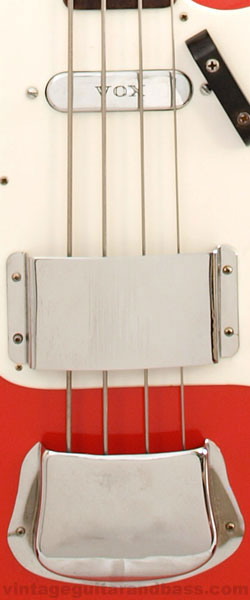

The Vox Symphonic bass was JMI's version of the Fender Precision, which they had already been distributing in the United Kingdom for some time in the early 1960s. The Vox has two pickups, compared to the Fender's one, but otherwise these guitars were very similar, having the same scale, construction, finishes and almost identical components. This bass certainly 'feels' very much like an early 60s Precision when played. All Vox Symphonic basses were produced at Vox's Dartford plant in the UK, and although small numbers were exported, the majority were sold in the UK.
 From the 1963 'Precision in Sound' brochure
From the 1963 'Precision in Sound' brochureThe 1963 Symphonic bass still had Vox's standard chrome plated pickups (V1 single coils) - as used on the majority of Vox's early Dartford-produced models (at least at some point). But the body is a nice solid chunk of mahogany, weighing in at a little over 4 kg; broadly similar to a Fender Precision, and with Vox's version of Fender's Fiesta Red finish. This contrasts to the laminate wood bodies that were regularly used on Bassmaster and Clubman basses around this time. This example has the early slab-body, with shallow body contours, front and back, and the neck joining the body at the 16th fret (later the body would become more contoured and join the neck at the 15th fret, making an overall slightly shorter bass - compare with a 1966 Vox Symphonic).
The least-expensive Vox instruments of the time have a bad reputation, at least in comparison to imported guitars from the USA; but their higher-end guitars are far more substantial, with far superior components, much weightier bodies, and are altogether considerably better instruments. Naturally this is reflected in the retail price; the Symphonic bass was one of their most expensive models, three times the price of Vox's Bassmaster. For example, in February 1964, the Clubman bass was listed at £26 5s, the Bassmaster at £31 10s; whilst the Symphonic was £94 10s. Even the new Phantom was only £84. The Symphonic never sold well; it could be argued that it was simply overpriced in comparison to other solid body guitars available in the UK at the time.
The 1963 bass shown here represents early Symphonic production, with Vox-branded chrome-covered V1 pickups and an un-branded bridge cover. Later examples had a large V on the cover, and although having the same scale, the bridge positioned further back on the body. This was due to the neck joining the body at the 15th rather than 16th fret.









The pots are British-made Morganite brand, two 1 mΩ volume and one 500 kΩ tone. The circuit is identical to that of a number of two-pickup Vox guitars and basses, Vox Shadow (2 pickup version), Vox Clubman (bass and guitar) etc.

Early examples of the Symphonic bass had a longer neck pocket than was necessary. The pocket actually extends right up to the neck pickup, yet for this bass, the end of the neck stops short of this point by some way. With the neck fitted, there is a small gap. Later examples had necks positioned so that their heel fills the whole pocket, making for a slightly shorter instrument overall. In order to keep the 34" scale, these basses have a bridge situated a small distance back from the example shown above.
£354